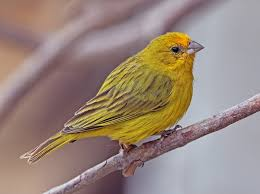Saffron Finch

Description
The saffron finch (Sicalis flaveola) is a tanager from South America that is common in open and semi-open areas in lowlands outside the Amazon Basin. They have a wide distribution in Colombia, northern Venezuela (where it is called "canario de tejado" or "roof canary"), western Ecuador, western Peru, eastern and southern Brazil (where it is called "canário-da-terra" or "native canary"), Bolivia, Paraguay, Uruguay, northern Argentina, and Trinidad and Tobago. It has also been introduced to Hawaii, Puerto Rico and elsewhere. Although commonly regarded as a canary, it is not related to the Atlantic canary. Formerly, it was placed in the Emberizidae but it is close to the seedeaters.
The male is bright yellow with an orange crown which distinguishes it from most other yellow finches (the exception being the orange-fronted yellow finch). The females are more confusing and are usually just a slightly duller version of the male, but in the southern subspecies S. f. pelzelni they are olive-brown with heavy dark streaks.
Typically nesting in cavities, the saffron finch makes use of sites such as abandoned rufous hornero (Furnarius rufus) nests, bamboo branches and under house roofs - this species is tolerant of human proximity, appearing at suburban areas and frequenting bird tables. They have a pleasant but repetitious song which, combined with their appearance, has led to them being kept as caged birds in many areas. Males are polygamous, mating with two females during the nesting season, and territorial, which has led to the species being used for blood sporting with two males put in a cage in order to fight.
Scientific Name
Sicalis Flaveola
Country Of Origin
Size
Life Expectancy
Noise Level
Characteristics
The saffron finch is a large and impressive finch and is really a cousin of the tanagers. Saffrons are handsome birds, but they can also be aggressive. Saffron finches should be kept only with other tough aviary species, like java finches and weaver finches.
Saffron finches are a much-loved garden bird throughout their native range, and they are also a common pet bird. The saffron finch’s song is cheerful but simple and is a nice addition to any bird aviary. Saffrons are happiest in aviaries because they are hyper active by nature. Sexing saffron finches is difficult for the untrained eye but females usually have darker and more pronounced black streaking on the back, and are slightly smaller than males. Saffron finches are cavity nesters and use a standard budgie nest box for breeding if provided one. They like coconut fiber and shredded palm fronds to stuff inside the box. They are usually good breeders, but will not tolerate nest inspections.
Behavior / Health Concerns
Saffron finches can be quite aggressive toward other birds and with their own kind if kept in groups. Otherwise, they are easy to please on a diet of budgie mix, chopped egg and greens. Saffron finches are one of the few finches that will sometimes eat fruit. Saffron finches are extraordinarily strong and hearty with no notable major health concerns.
Expert Advice
“Male saffron finches are sometimes used in fighting competitions in South America. Birds are paired off in small cages to square off in the style of cock fighting, but the finches are not usually injured.
“Saffron finches occur in two rare color mutations: white and pied.
“Saffron finches are considered to be an intermediary species between finches and tanagers, showing traits of both.
In South America, saffron finches are sometimes called “canario de terra” or “earth canary.”
— Karl Lieberman